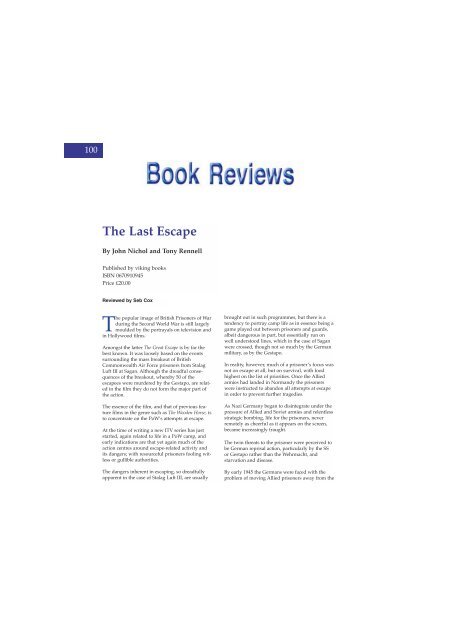Volume 6 No 4 - Royal Air Force Centre for Air Power Studies
Volume 6 No 4 - Royal Air Force Centre for Air Power Studies
Volume 6 No 4 - Royal Air Force Centre for Air Power Studies
You also want an ePaper? Increase the reach of your titles
YUMPU automatically turns print PDFs into web optimized ePapers that Google loves.
100<br />
The Last Escape<br />
By John Nichol and Tony Rennell<br />
Published by viking books<br />
ISBN 0670910945<br />
Price £20.00<br />
Reviewed by Seb Cox<br />
The popular image of British Prisoners of War<br />
during the Second World War is still largely<br />
moulded by the portrayals on television and<br />
in Hollywood films.<br />
Amongst the latter The Great Escape is by far the<br />
best known. It was loosely based on the events<br />
surrounding the mass breakout of British<br />
Commonwealth <strong>Air</strong> <strong>Force</strong> prisoners from Stalag<br />
Luft III at Sagan. Although the dreadful consequences<br />
of the breakout, whereby 50 of the<br />
escapees were murdered by the Gestapo, are related<br />
in the film they do not <strong>for</strong>m the major part of<br />
the action.<br />
The essence of the film, and that of previous feature<br />
films in the genre such as The Wooden Horse, is<br />
to concentrate on the PoW’s attempts at escape.<br />
At the time of writing a new ITV series has just<br />
started, again related to life in a PoW camp, and<br />
early indications are that yet again much of the<br />
action centres around escape-related activity and<br />
its dangers; with resourceful prisoners fooling witless<br />
or gullible authorities.<br />
The dangers inherent in escaping, so dreadfully<br />
apparent in the case of Stalag Luft III, are usually<br />
brought out in such programmes, but there is a<br />
tendency to portray camp life as in essence being a<br />
game played out between prisoners and guards,<br />
albeit dangerous in part, but essentially run on<br />
well understood lines, which in the case of Sagan<br />
were crossed, though not so much by the German<br />
military, as by the Gestapo.<br />
In reality, however, much of a prisoner’s focus was<br />
not on escape at all, but on survival, with food<br />
highest on the list of priorities. Once the Allied<br />
armies had landed in <strong>No</strong>rmandy the prisoners<br />
were instructed to abandon all attempts at escape<br />
in order to prevent further tragedies.<br />
As Nazi Germany began to disintegrate under the<br />
pressure of Allied and Soviet armies and relentless<br />
strategic bombing, life <strong>for</strong> the prisoners, never<br />
remotely as cheerful as it appears on the screen,<br />
became increasingly fraught.<br />
The twin threats to the prisoner were perceived to<br />
be German reprisal action, particularly by the SS<br />
or Gestapo rather than the Wehrmacht, and<br />
starvation and disease.<br />
By early 1945 the Germans were faced with the<br />
problem of moving Allied prisoners away from the
















